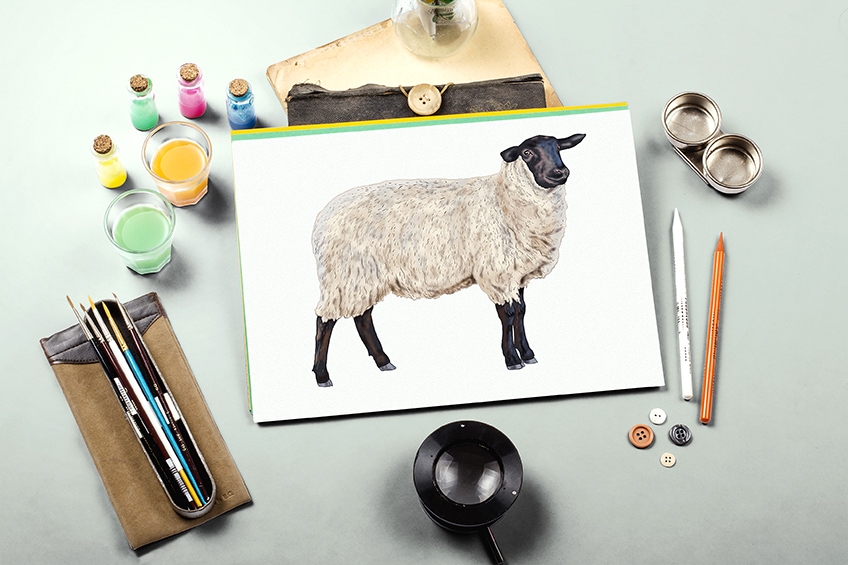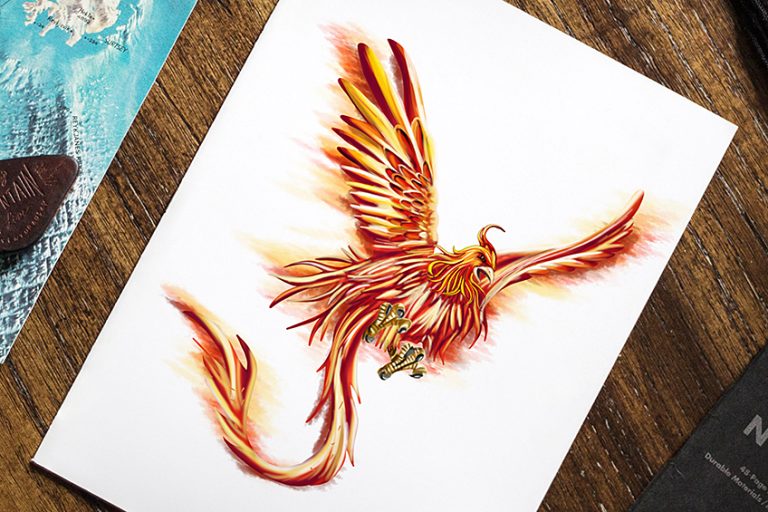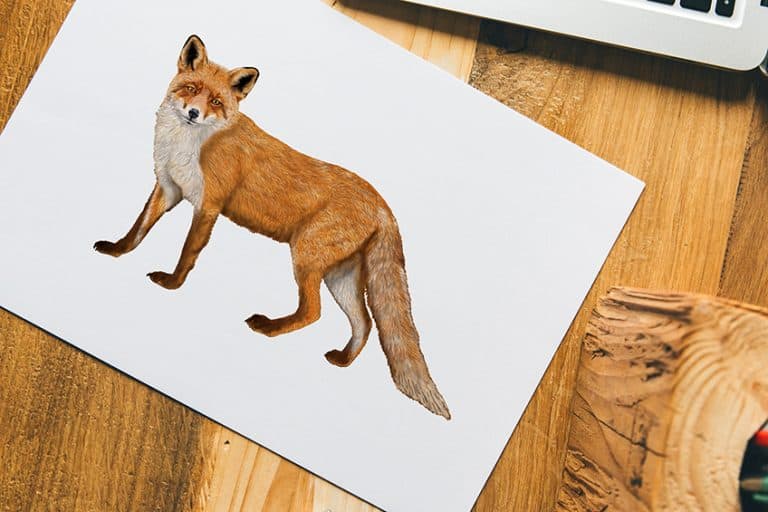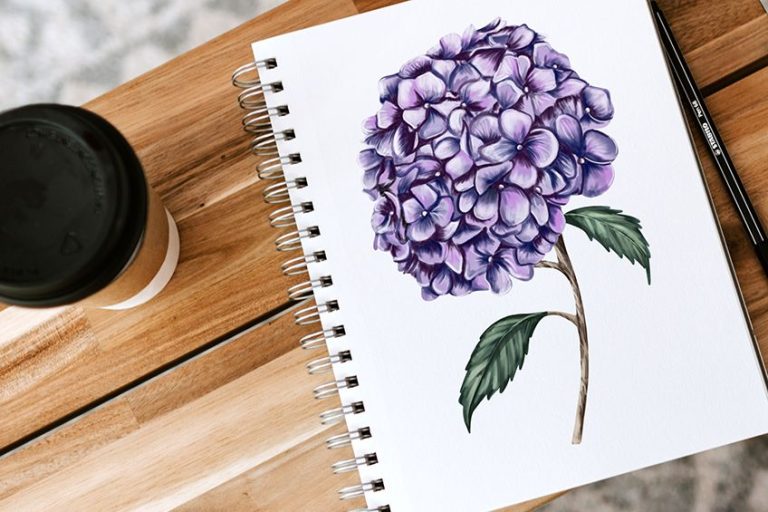How to Draw a Sheep – The Best Realistic Lamb Drawing Tutorial
Of all the farm-yard animals, sheep are some of the cutest. With their fluffy wool coats, coal-black faces, and flared ears, sheep make the perfect subjects for drawing. In this tutorial, which is part of our farm animal drawing series, we take you through all the most important steps to draw a realistic sheep. If you have been looking for the best tutorial to show you how to draw a lamb, then you have come to the right place. Gather your drawing supplies, find somewhere comfortable to work, and let us begin our sheep drawing!
Tutorial for How to Draw and Paint a Realistic Sheep
In all of our farm animal drawing tutorials, we aim to help you achieve the most realistic drawing in a few easy-to-follow steps. You can follow along with us and learn all of our best tips and tricks for creating and coloring a lamb sketch. From laying down construction lines to adding details to the face and wooly coat, you can find everything that you need to know in this sheep drawing tutorial. You can see an outline of all the steps we are going to take in the collage below.
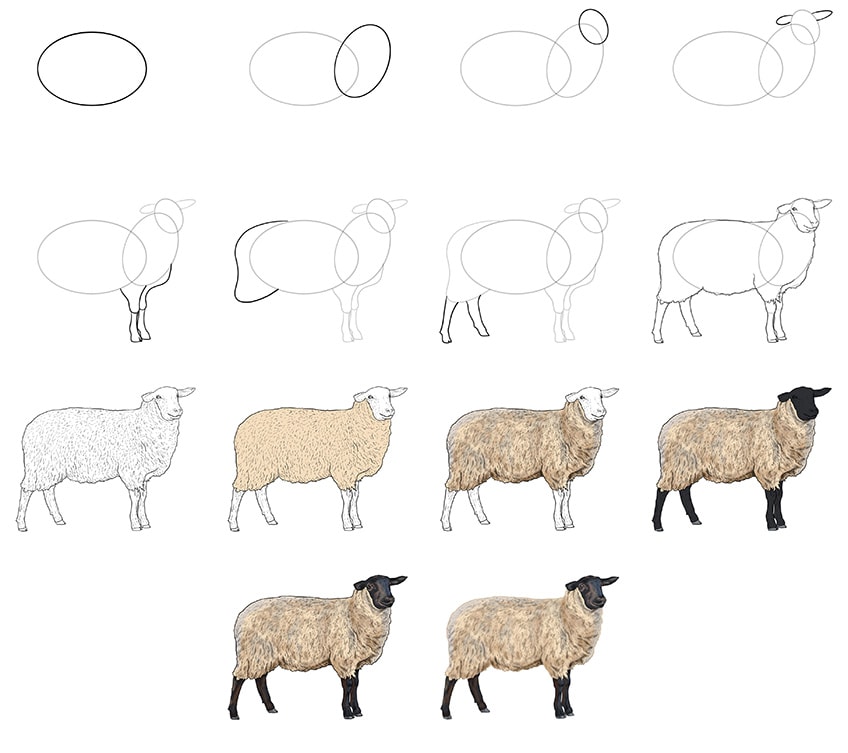
As with all of our tutorials, you can create your lamb drawing in any medium. Whether you love to use a drawing tablet, or you prefer to work with watercolor pencils or paints, it is very easy to adapt our sheep drawing tutorial to suit your needs.
Now that you have gathered your drawing supplies and are ready to learn how to draw a lamb, let us dive right in!
Step 1: Laying Down the Construction Lines
In all of our drawing tutorials, we begin by using construction lines and shapes to lay down the basic shape of our animal. We find that using construction lines is the most reliable way to ensure that you have the correct proportions and shapes before you begin adding the time-consuming details. In this first step, we are using a single oval shape to construct the general shape of the sheep’s main body. You do not want this oval to be too elongated, as sheep have fairly round bodies.
The most important thing to ensure in this first step is that your main body oval sits in the center of your canvas with plenty of space on all sides. In the next few steps, we will be adding the legs and head which need space.

Step 2: Outlining the Sheep’s Chest
If you look at the final result of this tutorial, you will see that the sheep’s head does not simply extend from the front of its body. Sheep have a fairly long neck and a large chest, which we need to lay down with construction lines in this step. You are going to use another oval, but this time it should be slightly smaller and more elongated. Draw the angled oval shape overlapping with the very front tip of the main body oval.
You want this oval to lean towards the right side of your canvas, and the top of it should sit a little higher than the highest point of the main body oval.
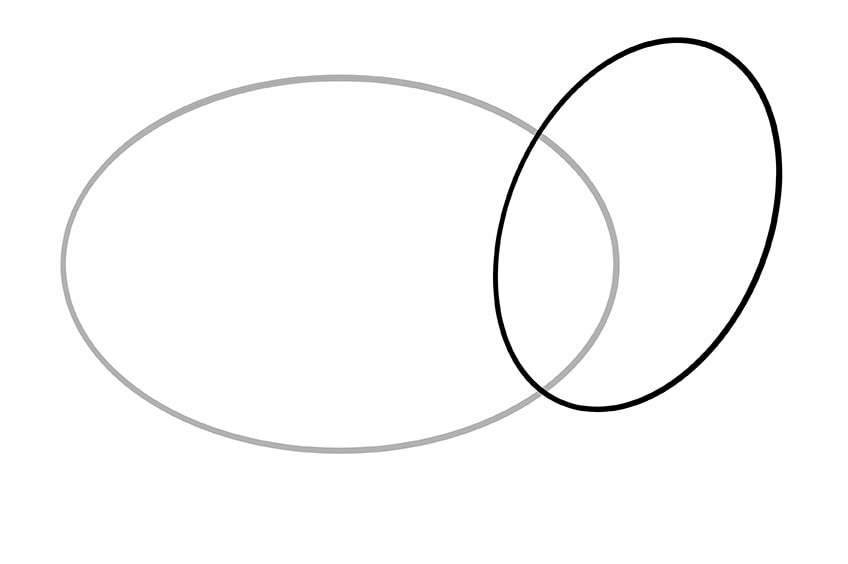
Step 3: Drawing the Shape of the Head
Now that we have laid down the chest area which connects the sheep’s body and head, we can draw the construction shape for the head. For the head, you want to use a much smaller oval shape and place it at the top of the chest oval.
This oval should be angled towards the left, opposite to the chest oval.

Step 4: Constructing the Ears
In this fourth step, we are still focusing on construction shapes, so you are going to use two very simple shapes to lay down the sheep’s ears. On either side of the top of the head oval, draw two incomplete oval shapes extending from the head. Although these are only construction lines so you do not have to be too precise about their shape, it is important to note the difference in shape and length between them.
If you look at our example below, you will see that the ear on our right is longer and more pointy than the left. The reason for this is perspective. The ear to our left is extending slightly forwards, while the right is going straight outwards.

Step 5: Drawing the Shape of the Front Legs
Up until now, all of our construction shapes have been ovals or shapes like ovals. In this step, we are going to create more freehand construction lines to lay down the shape of the sheep’s front legs. Begin just below the halfway point of the front of the chest oval, and take a line down to create the thigh of your sheep drawing. When this line becomes level with the bottom of the chest oval, you can create a rounded 90-degree turn to the left and then curve the line down to create the upper part of the front leg. For the second leg, take a U-shaped line down from the bottom of the chest oval and finally joining with the bottom of the main body oval.
Finally, from the bottom of each thigh, create two elongated hooves, with a heel bump at the back and a sight point at the front. For added realism, you can add a little slit at the very front of the second hoof.
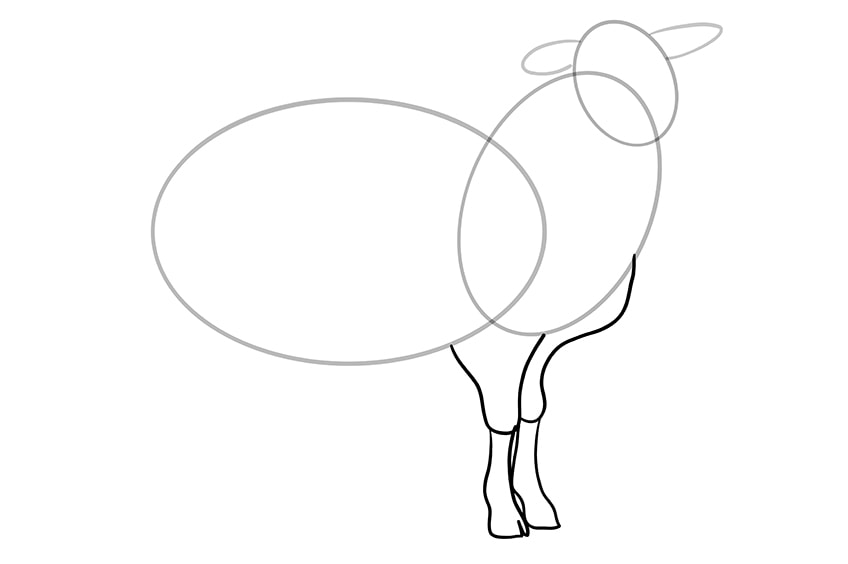
Step 6: Creating the Shape of the Rump
At this stage, you can probably start to see the final shape of the sheep drawing coming together. In this step, we are going to create the shape of the back end of the sheep. Sheep have quite square rumps, so you are going to begin drawing a line from just behind the top of the main body oval. Take this line backward, before curving down and back slightly towards the back point of the main body.
Finally, finish the back of your sheep by curving this line out again quite sharply, and then bringing it back up to meet the bottom of the main body.
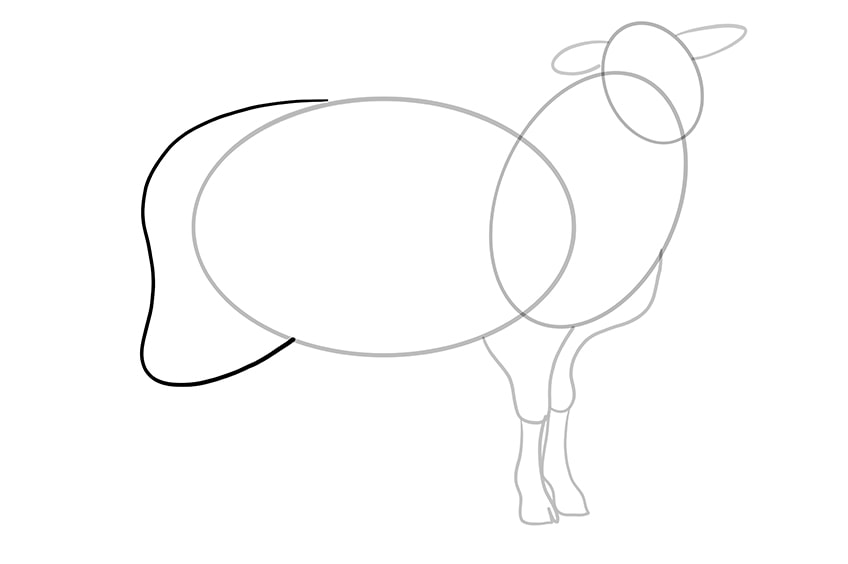
Step 7: Time to Draw the Back Legs
In step seven, we are going to create the outline for the two back legs of your lamb drawing. Begin with the very back foot, taking a line down from the very back and bottom point of the rear end. You can create a similar hoof shape at the bottom, with a slightly more pointy heel and a split in the front. For the second back leg, start on the inside and bottom of the rear end, and draw the final hoof angled slightly towards the front of the sheep’s body.
To nail a realistic perspective in your sheep drawing, both of the back legs should start on the line of the rear end, as they are poking out from beneath the wool coat. The very back leg should also be angled slightly towards the back of your canvas, and both hooves should point towards the front.
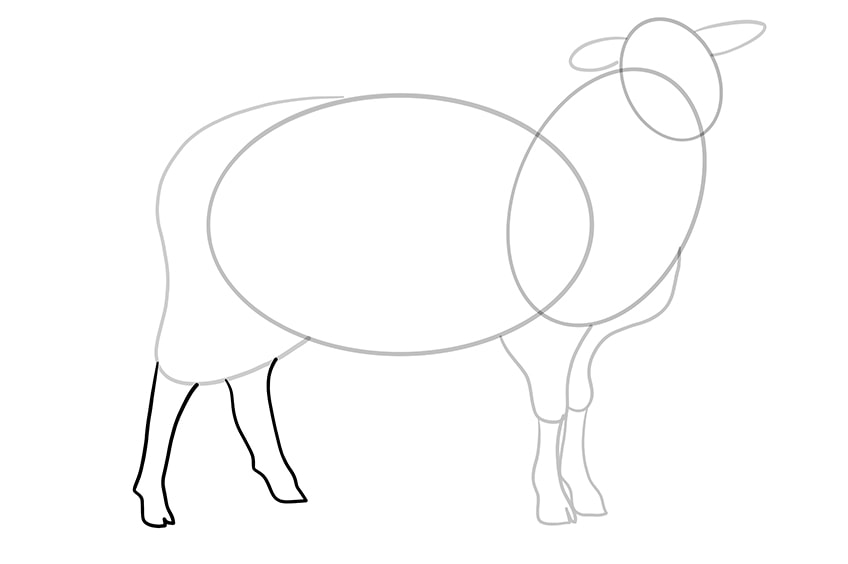
Step 8: Creating the Final Outline of Your Sheep Drawing
Up to this point, most of our drawing has been purely construction. In this step, it is time to tie together all of our construction lines to create the final outline of your lamb drawing. Begin by outlining the shape of the sheep’s head.
If you take a look at our example below, you will see that the sheep’s head is not an oval like the construction shape. Bring the sides of the face slightly inwards, and then create a slightly squared-off nose.
For the left ear, carry the head outline around the ear without separation. To maintain the perspective, you need to use a line to separate the right ear from the space within the head. To finish the head outline, you can add facial features including eyes close to the ears, nostrils, and a small wiggly line for the mouth.
Use wavey and scribbly lines to outline the rest of the sheep’s body to give the illusion of a wooly coat. You can follow your construction shapes very closely, just adding a few raggedy bits of wool around the bottom of the body. Lastly, add an additional line just above the bottom of the hooves to create more realistic detail.
When you are happy with your outline, you can erase all remaining construction lines.
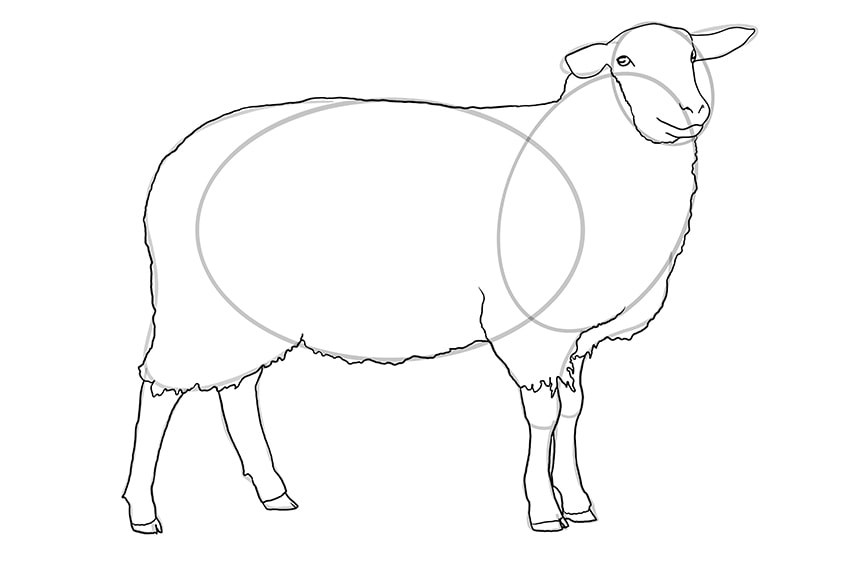
Step 9: Creating Realistic Texture
Although time-consuming, this step is fairly simple. Using short wavy lines, fill the entire body of your sheep with a wool-like texture. These lines should not overlap each other, and the head, ears, and feet should be slightly less textured than the main body.
To make sure that the fur of your sheep drawing is as realistic as possible, use the curvature of the outline to guide the direction of your lines. The lines should curve around the neck and chest, and flow down from the sheep’s back.
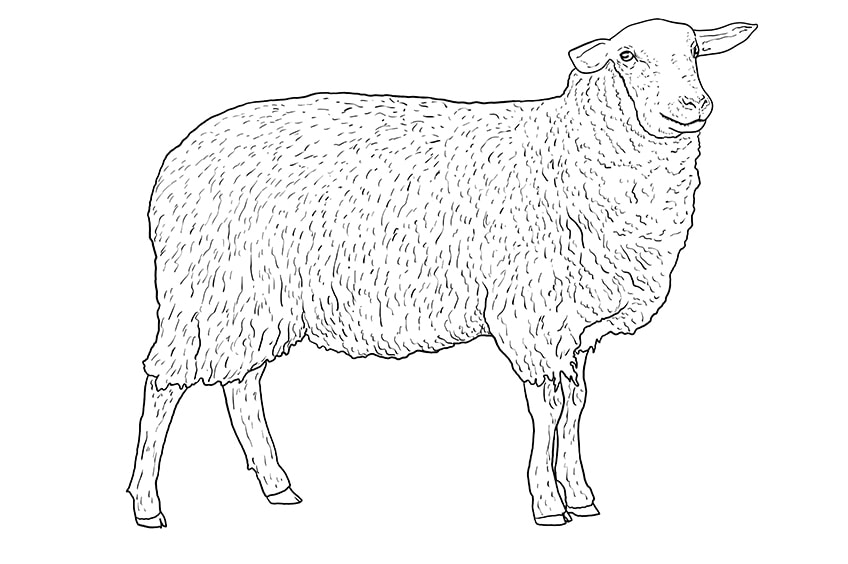
Step 10: Adding the First Coat of Coloring
In order to create realistic coloring for any animal drawing, it is always best to build the color up in a few layers. Although sheep are white, we need to start with a neutral base color to create depth and dimension. Use a light tan shade of beige, and fill the entirety of the main body with this shade.
The head and feet are going to be black, so you can leave these areas blank for now.
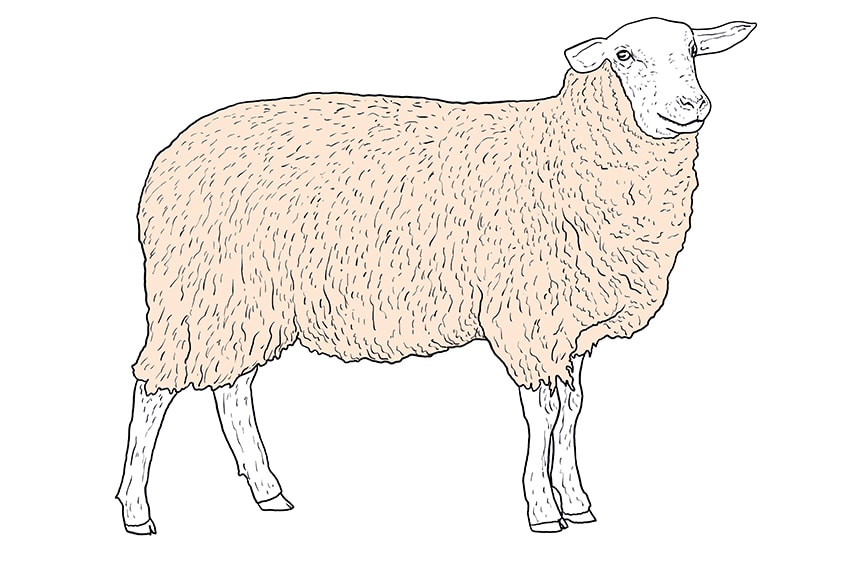
Step 11: Blending Your Colors
In this step, you are going to need shades of light brown and black to create different patches in the wooly coat. Begin by painting some patches of light brown throughout the sheep’s body. You can then go in with just a touch of black paint and darken some of these patches. The most effective coloring method is to lightly dab the color onto the sheep’s body without blending it too much.
In order to emphasize realistic perspective, you want to focus your darker colors along the bottom of the sheep’s body, below the head, and around the chest.
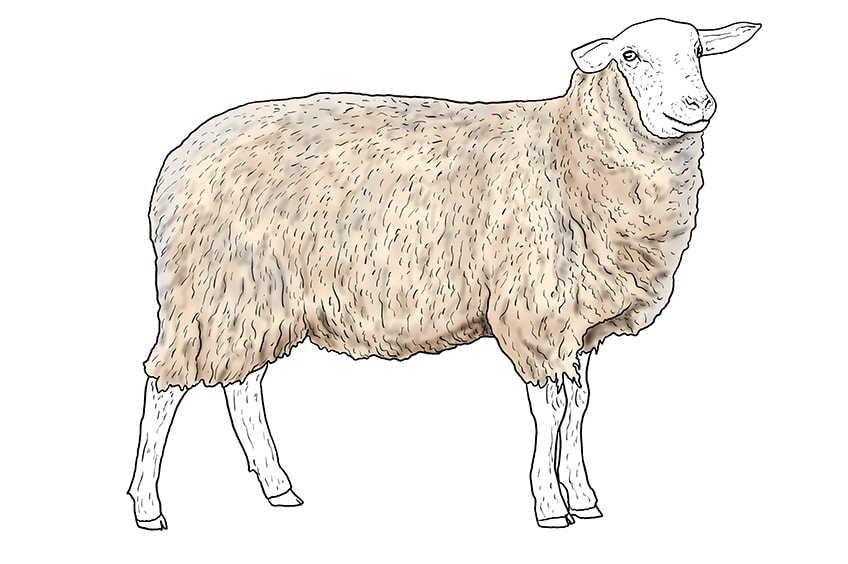
Step 12: Coloring the Remaining Body Parts
Using a dark gray shade, color in the head and legs of your lamb sketch. The very bottom of the hooves should be slightly lighter than the rest of the legs and the head, so use a light gray color to fill this area.
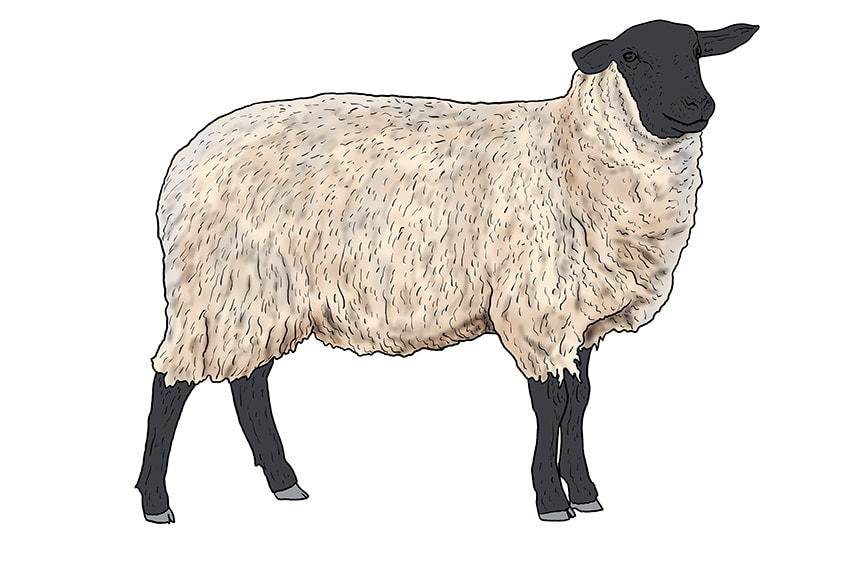
Step 13: Adding Highlights to Your Sheep Drawing
Shadows and highlights are fundamental tricks for creating realistic texture, depth, and perspective in any drawing. For this step, you are going to need a shade of white, tan, peach, and blue-green to add highlights to the darker parts of your sheep’s body.
Begin by adding a touch of white paint to the sheep’s eyes, creating the glint of light reflecting in the iris. Next, use your tan shade and add a little shaping to the face of your sheep, adding highlights to the places that sit higher than others and would naturally catch the light. Focus some highlighting on the insides of the ears, and around the mouth and nostrils. For the lightest parts, use your light peach shade to emphasize the highlights.
For the final part of this step, use your blue-green color to add some further shading to the face and legs of your sheep drawing.

Step 14: The Finishing Touches
This final step is optional, but it is a great way to level up the realism of your lamb sketch. In this step, you can remove the outline of your sheep drawing with one of two methods. If you can simply erase the outline on your graphic tablet then you can finish your sheep drawing quickly. If you have used a more physical drawing medium, you can use your light tan color to paint over the outlines and erase them.
You can now add final details to your lamb drawing by using this tan shade to delicately trace the fur lines throughout the body.

Congratulations on finishing our quick and easy sheep drawing tutorial. If you came into this tutorial wanting to know how to draw a sheep realistically, you now know all the best tips and tricks for achieving maximum realism. Hopefully, you are happy with your final lamb drawing, and you are excited to draw some more farm animals.
Frequently Asked Questions
Is It Easy to Learn How to Draw a Sheep?
Drawing a sheep is actually a very simple process when you break it down into a few steps. Our sheep drawing tutorial makes it very easy to learn how to draw a lamb.
How Can You Perfect the Realism in a Sheep Drawing?
The best way to create a realistic sheep drawing is to focus on nailing the perspective and using highlights and shadows to create depth and dimension. Our easy lamb sketch tutorial gives you all the best tips and tricks for creating a realistic sheep drawing.
Matthew Matthysen is an educated multidisciplinary artist and illustrator. He successfully completed his art degree at the University of Witwatersrand in South Africa, majoring in art history and contemporary drawing. The focus of his thesis was to explore the philosophical implications of the macro and micro-universe on the human experience. Matthew uses diverse media, such as written and hands-on components, to explore various approaches that are on the border between philosophy and science.
Matthew organized various exhibitions before and during his years as a student and is still passionate about doing so today. He currently works as a freelance artist and writer in various fields. He also has a permanent position at a renowned online gallery (ArtGazette) where he produces various works on commission. As a freelance artist, he creates several series and successfully sells them to galleries and collectors. He loves to use his work and skills in various fields of interest.
Matthew has been creating drawing and painting tutorials since the relaunch in 2020. Through his involvement with artincontext.org, he has been able to deepen his knowledge of various painting mediums. For example, watercolor techniques, calligraphy and lately digital drawing, which is becoming more and more popular.
Learn more about Matthew Matthysen and the Art in Context Team.


